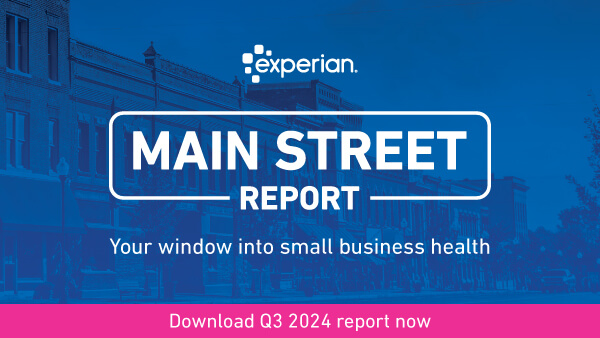White Paper
Published October 20, 2015
Commercial Commercial InsightsWhen attempting to determine a small business's credit risk, which is more useful, the company's credit history or its owner's? For decades, conventional wisdom has held that a business owner's personal credit history alone can be used to judge his or her company's creditworthiness. Many lenders have tended to see small businesses and Small Business owners as one and the same, their funds so frequently commingled as to make the two entities virtually indistinguishable. However, this strategy is not always successful. A business owner with good personal credit still can have a failing company, and someone whose personal credit is messy still can own a successful business. Since a bad call can cost a creditor thousands, perhaps tens of thousands, of dollars, Experian® decided to test the conventional wisdom for itself.
Complete the form to access the white paper
This site is protected by reCAPTCHA and the Google Privacy Policy and Terms of Service apply.
Thank you for your interest
Your free Experian resource is now available. Enjoy!
 Video
Video
Navigating Industry-Specific Risks
As published on the Business Information blog, Experian's latest Commercial Pulse Report highlights how risk profiles vary significantly by industry and business age.
🔹 New businesses in sectors like Construction and Food Services face higher delinquency rates, signaling elevated credit risks.
🔹 Meanwhile, industries like Retail and Healthcare maintain stable performance, regardless of business maturity—offering balanced opportunities for lenders.
Understanding these dynamics is critical for tailoring lending strategies, mitigating risk, and supporting business growth across industries.
Check out the full report to see how these trends could impact your strategy!
 Webinar
Webinar
Q3 2024 Quarterly Business Credit Review
Watch the recording of the Quarterly Business Credit Review webinar, where Experian shared and discussed critical insights from the latest Main Street Report.
Why you should watch:
- Leading Experts on Commercial and Macro-Economic Trends
- Credit insights and trends on 30+ Million active businesses
- Industry Hot Topics Covered (Inclusive of Business Owner and Small Business Data)
- Commercial Insights you cannot get anywhere else
- Peer Insights with Interactive Polls (Participate)
- Discover and understand small business trends to make informed decisions
- Actionable takeaways based on recent credit performance
Visit our Commercial Insights Hub for more economic insights and reports on small business.
 Report
Report
Q3 2024 Experian Main Street Report
The U.S. (United States) has been in a state of suspended animation from a small business perspective. The domestic election cycle was full of promises focused on government spending to resolve consumer and small business perceived challenges for the next four years. As we emerge from the election cycle, with a clean transition expected, what rhetoric will become a reality is creating uncertainty among lenders and small businesses. Macroeconomic indicators are leaning positive, while stubborn inflation increases prices and borrowing costs. Lenders are targeting a looser environment for underwriting as cashflows remain positive and small businesses feel the rush of holiday shopping. Growth is coming in 2025; the question is how quickly companies can prepare and maneuver through the next 6 months of policy and global volatility.
 Video
Video
Construction Industry Resilience
As published on the Business Information blog in our post titled Construction Industry Resilience, Experian wrote about how the economy continues to evolve and highlights some interesting trends in the housing market and for the many small businesses in the construction industry. This video offers some highlights from our study as well as a current read on macroeconomic conditions.
🔑 Additional Highlights:
- Businesses are shifting from term loans to commercial credit cards for greater flexibility.
- Delinquencies in construction remain lower than other industries, showcasing financial strength.
- High housing demand continues to fuel opportunities despite rising costs and tight credit.
Whether you're navigating financing strategies or tracking industry growth, these insights are a must-read for construction professionals and business analysts.
📥 Download the full report now and stay ahead of the trends shaping the construction landscape.
Check out the full report to see how these trends could impact your strategy!